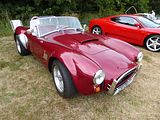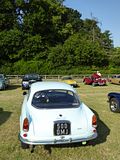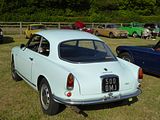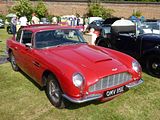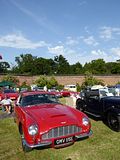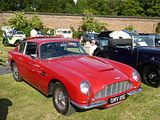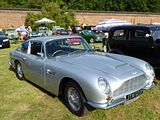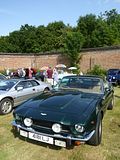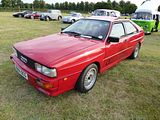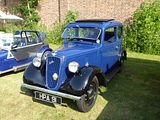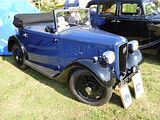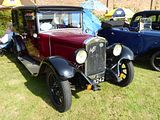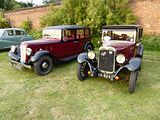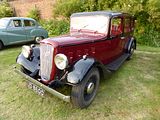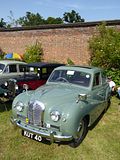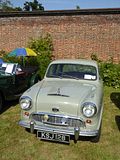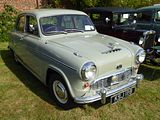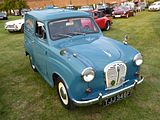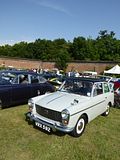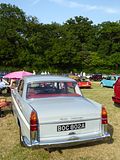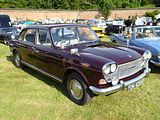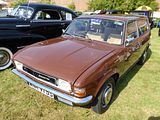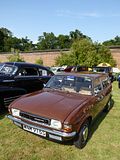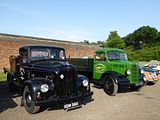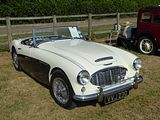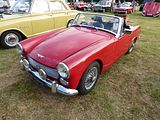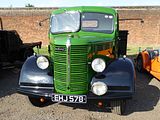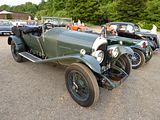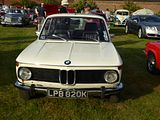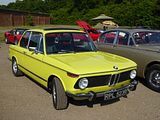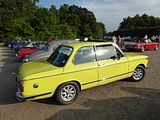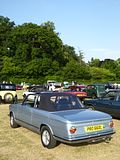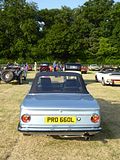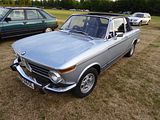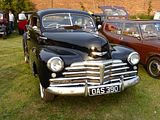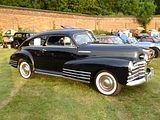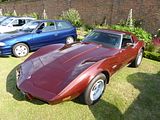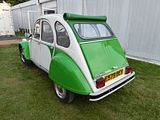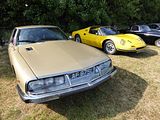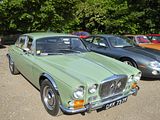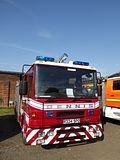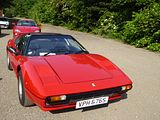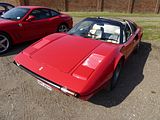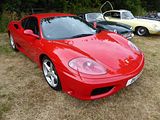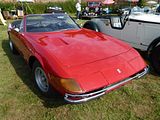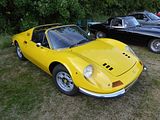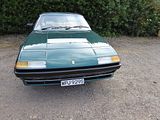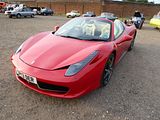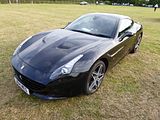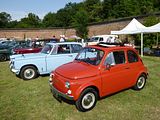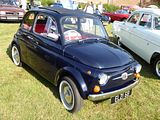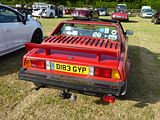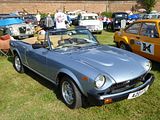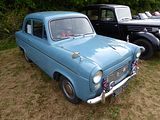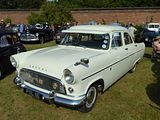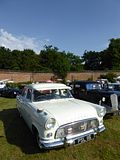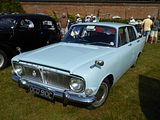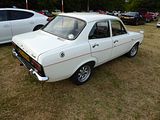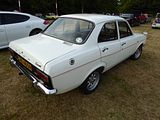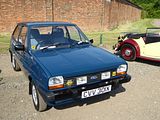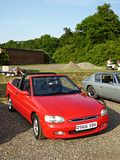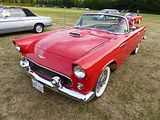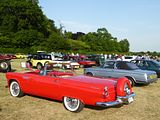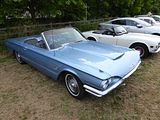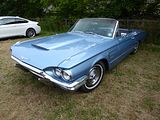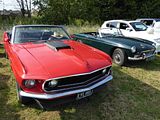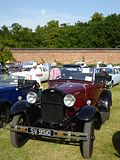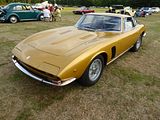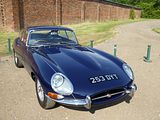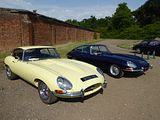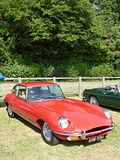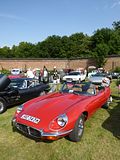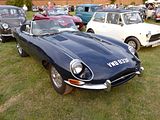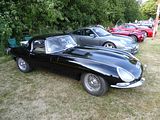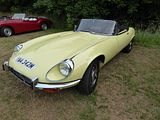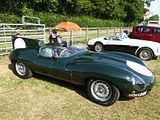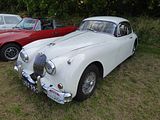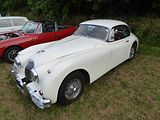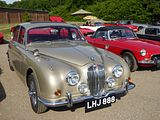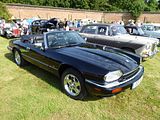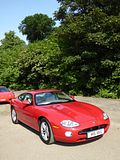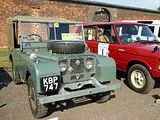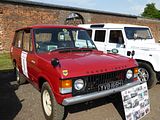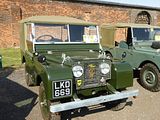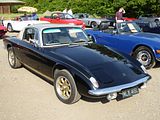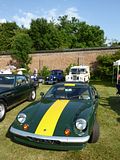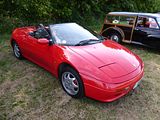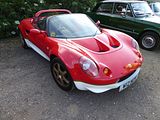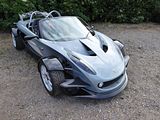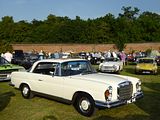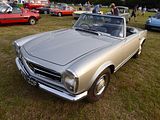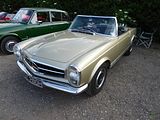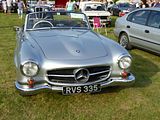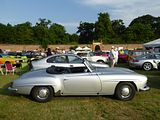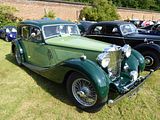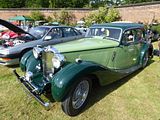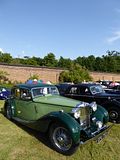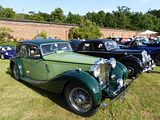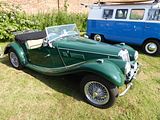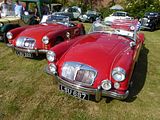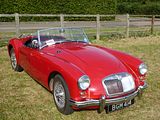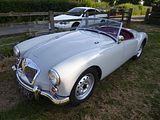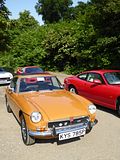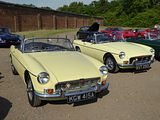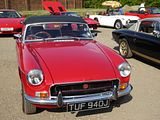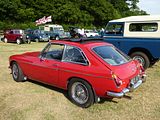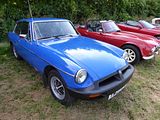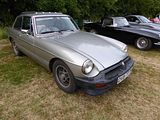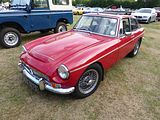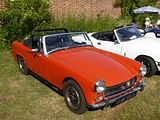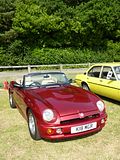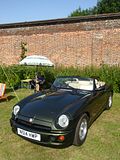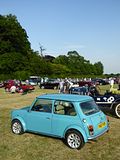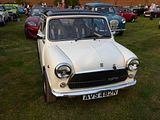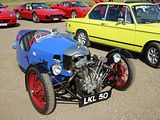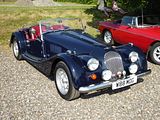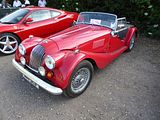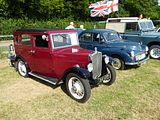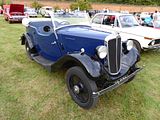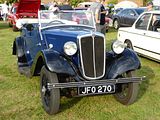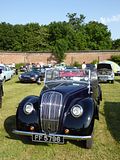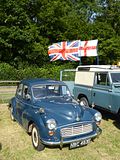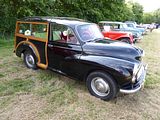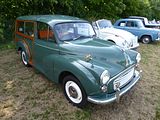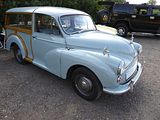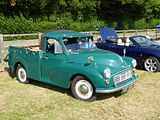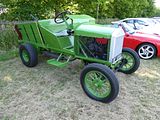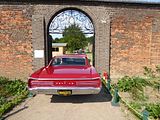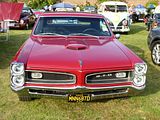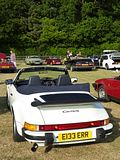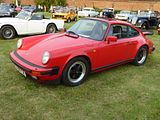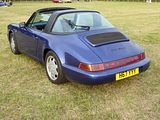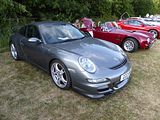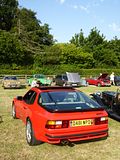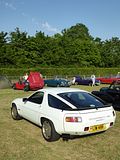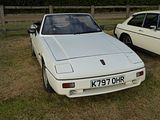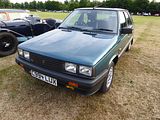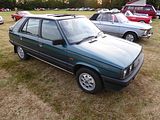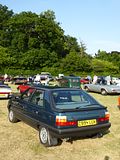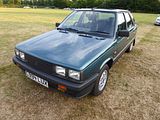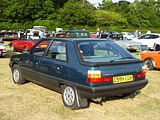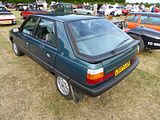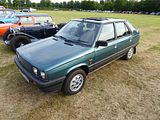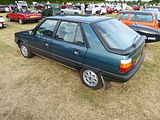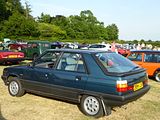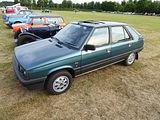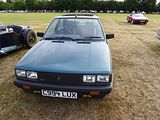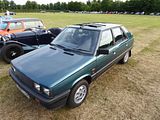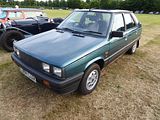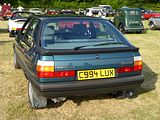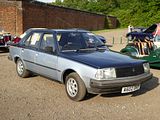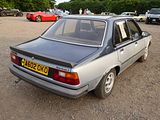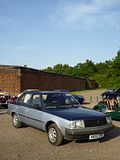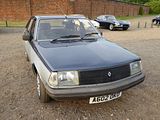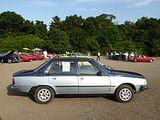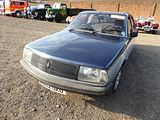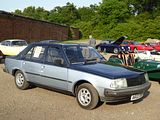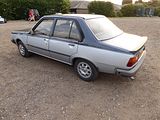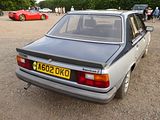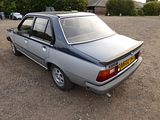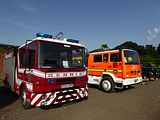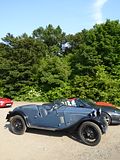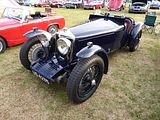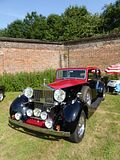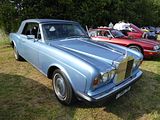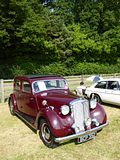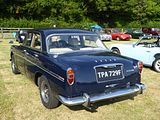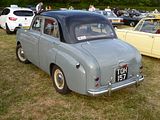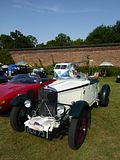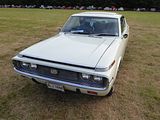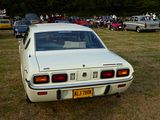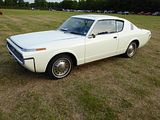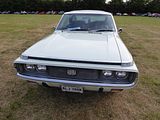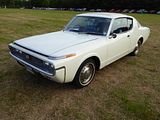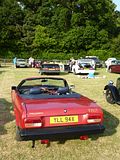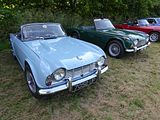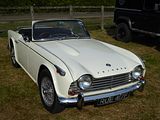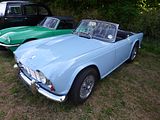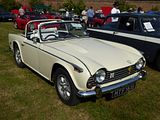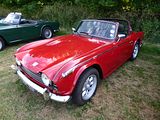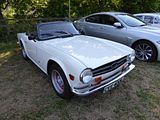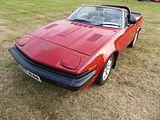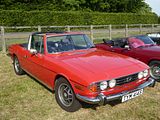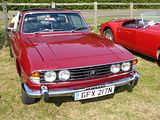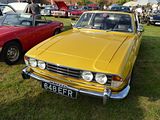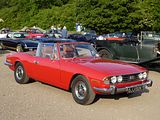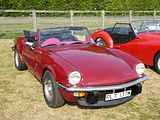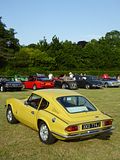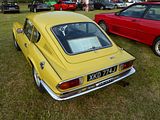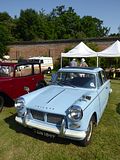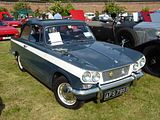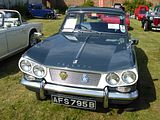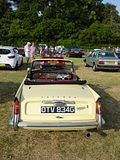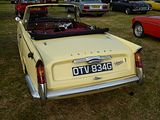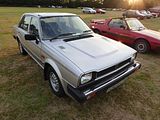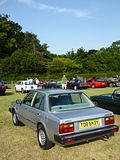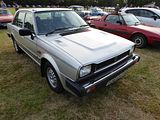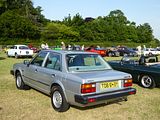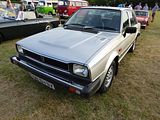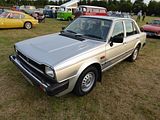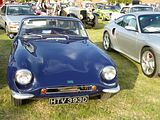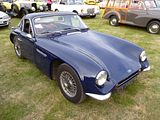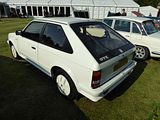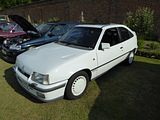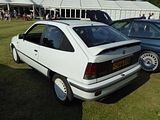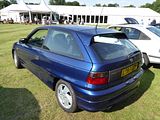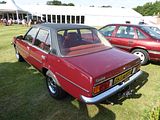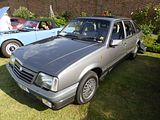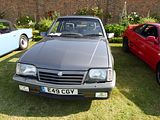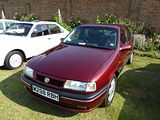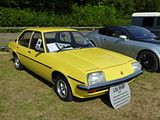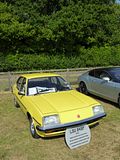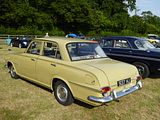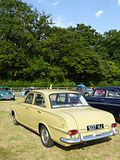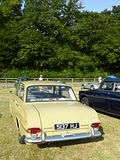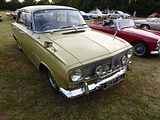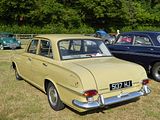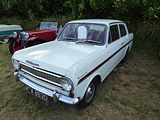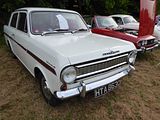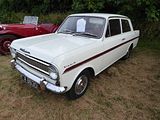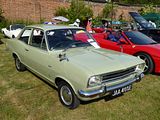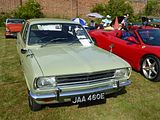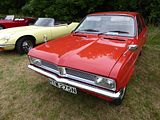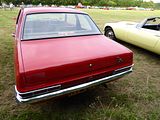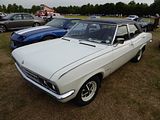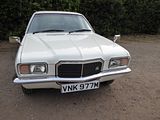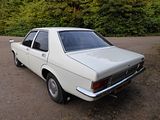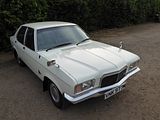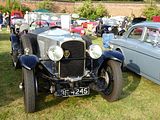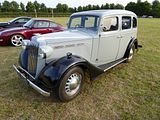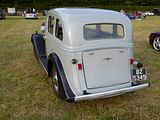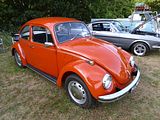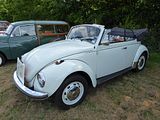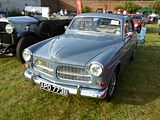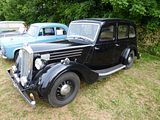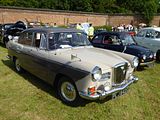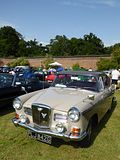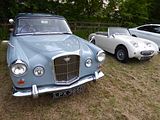There is something quintessentially English about this event. I’m not sure whether it is the setting – in and around the traditional Walled Garden on the Luton Hoo Estate – or the fact that many of the attendees bring an evening picnic which they set out in close proximity to the car in which they have arrived. Either way, it is massively popular, with bookings for a place inside the walls of the long established Walled Garden claiming all the available spots literally within hours of the date being announced. Fortunately, there is plenty of space for an overflow collection of cars in an adjoining field area, which has more than enough capacity for all who book to bring their cherished classic along for everyone to enjoy. And those who come in a “modern”? Well, another field again will house all of those, and in exchange for a modest £3 admission fee, you can get to see in excess of 300 interesting cars gathered together on one of the longest evenings of the year. I’ve attended the event a couple of times in the past, and enjoyed it very much. Although it does run on until dusk, I had learned that many of the attendees do arrive as early as 4pm, and some will start to depart after a couple of hours, so it does pay to get there as early as you can. Fortunately, I managed to keep the work diary reasonably clear, and was able to time my trip around the M25 and up the M1 as far as Junction 10 to beat the worst of the evening rush hour. There was no respite from the heat, though, as the 2015 event happened to coincide with the hottest day of the year, when the thermometer had gone well past 30 degrees. Sellers of ice creams and cold drinks no doubt rubbed their hands with proverbial glee, but even those who managed to eschew these temptations had plenty to enjoy in a late afternoon and evening which saw quite a variety of cars, some of which I had seen at this event before and plenty of which I had not. Whilst there were some models and marques predictably well represented, there were a few real rarities as well, making this a particularly rewarding event to attend. I stayed until dusk, enjoying seeing the cars, and talking to a number of the owners and fellow enthusiasts. As is often the case with events like this, I did not manage to point a camera at everything that was there, but there is plenty that is presented in this report so you can enjoy the event vicariously.
AC
This was perhaps the perfect weather to enjoy a Cobra, or rather “Cobra-style” car, as this immaculately turned out car should be called, as, nice though it is, it is not one of the original AC cars from the 1960s.
ALFA ROMEO
Slightly surprisingly, the only Alfa present at the event was this one, a gorgeous 750 Series Giulietta Sprint which arrived relatively late in the evening.
ASTON MARTIN
The DB6 will mark its 50th anniversary next year, and you can be sure that there will be of occasions when the car has a prominent position at events, and in coverage in the specialist classic motoring press. Not that the car goes unrecorded even now. With prices of its earlier DB5 and DB4 relatives having climbed into the stratospheric, much of the buying public’s interest has turned to this version, which to my eyes at least looks at least as good as its forebears. Produced from 1966 to 1970, the DB6 was conceived as a stop gap until the William Towns styled DBS was ready, but it ended up running alongside the new car for some time, before production of this lovely Coupe and even lovelier Volante open top model ceased. Two example of the car were here.
The V8 was the evolution from that DBS model of 1967, and it was produced until 1988, though at nothing like the rate at which Astons are produced today. Even so, with a good survival rate, there are plenty of nice examples around, and this is one of them.
AUDI
I have a very soft spot for the original Quattro, the car which completely transformed not just the world rallying scene, but Audi’s image from a maker of nicely finished but slightly dull cars to one which enthusiasts would genuinely lust after. Whilst the world has moved on, and most Audis these days are simply nicely finished premium products that sell in volume, there are still plenty of special cars in the range, all with a quattro badge on them, and generally bearing the letters R and S, which have massive driver appeal, and more than a little of the DNA of this 1980 legend.
AUSTIN
The pre-war Austin was well represented. That does not mean just the diminutive Seven, though of course there were a couple of very different examples of Herbert Austin’s baby which was sold between 1922 and 1939.
There was also a nice open topped version of the larger Ten.
Most splendid of the pre-war cars, though were this pair of larger cars, the Six. Unlike the smaller models where the RAC Horsepower rating gave the cars their name – often augmented by a place name, Six meant the number of cylinders. These were big and heavy cars, aimed at the affluent middle class. Both the machines seen here were at the event last year. The later of the pair, called a York, dates from 1926, and has recently emerged from a meticulous restoration which has taken place gradually over the past 30 years and the result is a very imposing vehicle indeed.
Post war, Austin adopted County names for their cars, and there were examples of the A40 Somerset and its replacement the A50 Cambridge as well as an A35 Van from this period of the company’s product range on display.
The A40 which appeared in the autumn of 1958 was the first BMC car to be styled by Pininfarina. A two box design, it initially had just a drop down boot lid, but it did not take long before a Countryman version was offered, with lifting rear window as well, leading some to christen this the first hatchback. That’s a moot point, but the A40 established itself as a worthy rival to the in-house competition from Morris’ Minor as well as the cheaper small Ford Anglia and Prefect and the Standard Ten. 1962 saw an update to the styling, to create a Series 2 model which was produced for a further 5 years by which time another Pininfarina design, the ADO16, Austin/Morris 1100 had taken over the majority of sales in this class.
The A60 Cambridge arrived in 1962, too. A tidying up of the Farina designed 1959 model, the tail fins were lessened, and a new front end made the car look neater, and the larger 1622cc B Series engine provided a welcome uplift in power for what was a large and heavy car.
First shown in 1967, the 3 litre was a replacement for the A110 Westminster. It took over a year to get the car into production, and when the press did get to drive it, it is fair to say that they were not exactly bowled away by it. An enlarged version of the ADO17 “Landcrab” Austin 1800, this car had rear wheel drive and a 3 litre C Series engine under the bonnet. It was certainly roomy, but that was not enough for those who wanted more evidence of the money they had spent, so brasher cars like the Ford Zodiac and Vauxhall Viscount took sales away from this car, even if the reality is that they were no better. With only 8000 cars sold by 1970, the Austin 3 Litre was quietly dropped from the range. They are rare now, but to my mind, quite elegant and more interesting than the market (with the notable exception of Martin Buckley who rather likes them) thinks. This particular car has been at the event every time I have attended.
Elegant is probably not the word that I, or anyone else would use to describe the Allegro Estate, though the passage of time has allowed us to get more used to the looks. You don’t see Estate models that often. This was a Series 2 car in the period Russett Brown colour.
Final Austin was a commercial model from the 1950s, an Austin 301. This was a copy of the more common Morris Commercial LC5 with carrying capacity of 30 cwt. Both Morris and Austin versions (the only difference was the badges) had the Austin A70 car engine – 4 cylinder 2199cc petrol engine, which was connected with a 4-speed gear box, though a diesel engine was also available as an option. The Morris LC range had its origins in the pre-war LC 25/30-cwt vans and trucks. The Morris LC5, which was available only as 30-cwt truck from 1953 was joined in 1954 by an LC05 diesel version. It continued in production until 1960, when it was replaced by the entry-level versions of the all-new FG truck. Production of the Austin 301 stopped in 1957.
AUSTIN HEALEY
There were just two Austin-Healeys, as far as I recall, and certainly as recorded by camera, a 3000 and a Sprite Mark III
BEDFORD
This OLB Lorry dates from 1952. One of the “O” Series Bedfords, that shared its distinctive front end with the well known OB Bus that first appeared in 1939, and was produced in small numbers before the War intervened and then again unchanged post War until 1951, the O Series trucks were one of three series of that the Luton manufacturer introduced to meet the haulage needs of its customers. Each was a 2-axle vehicles with a separate bonnet, and they were called “K”, “M” and “O”. The K Series had a carrying capacity of 1.5-2.0 tons, and had a a standard wheelbase of 3050mm, while the “M” Series could carry 2 – 3 tons and were offered with two wheelbases of 3050 mm and 3630., and the largest, the “‘O” could haul 3 – 5 tons and came in 13 different designs, also with two wheelbase lengths. They all used the same 6-cylinder engine which generated a heady 72 hp, coupled to a 4-speed transmission, and had leaf-spring suspension and hydraulic brakes. Models with a carrying capacity of 3 tons used a vacuum brake booster. The vehicles were adapted for military use during the War and then production resumed after the cessation of hostilities, with the “O” Series now offered in OLA and OLB versions, differing in haulage capacity. The design was finally retired in 1953.
BENTLEY
Even by the standards of today’s rather bloated new cars, this 3 litre is a physically large and imposing machine.
BMW
This is a well known car, the 2002 belonging to David Evans of Classic and Sports Car. David publishes updates on his ownership experience, which now extends over a period of more than 10 years, at frequent intervals in the magazine, and as he uses the car a lot (it has nearly amassed a quarter of a million miles from new), I have seen it several times in various parts of the country. When I first saw it at this event, he was standing by it, deep in conversation with someone, and 20 minutes he was still there. As he had arrived quite late in the proceedings, I did wonder what sort of report he would produce. Sure enough, later on I did encounter him talking to other owners, with notebook in hand, so – unashamedly – I have used some of what he gleaned to add a few more details to various parts of this report. With elsewhere in the venue, I was finally able to get a clear photo of his car, too!
David’s was not the only BMW 2002 present. Parked up in the area immediately outside the walls was another car, a Golf Yellow model, also a 2002, that Brett Israel has owned for 21 years. Apparently this one dates from 1972, but it is on an R-plate because it was bought by a soldier who brought it back to the UK in 1977. It was ordered new with a five-speed dogleg ’box, a limited-slip diff and a factory steel sunroof, which is unusual for a standard ’02. It looked superb
The third BMW to catch my eye was also an 02 series car, but this was one of the Cabrio models that was produced by Baur.
BRISTOL
The 405 was made between 1954 and 1958 in both four door form, and as seen here, as a Drophead Coupe. Far more of the former were made (297 cars), with just 43 open models produced, so neither were exactly numerous when new. These days it is just as likely – or rather unlikely – that you will see either bodystyle.
CHEVROLET
As American did not enter the War until 1941, after the bombing of Pearl Harbour, car production continued long after it had ceased in Europe. During this period, the external styling continued to evolve, with flowing lines and fastback rear ends as exemplified by this 1941 Stylemaster 2 door deLuxe proving to be generally popular with those at this event.
Sole example of the Corvette on show was this C3 model Stingray, from the mid 1970s
CITROEN
Two very different classic Citroen models were here, each desirable but for different reasons. From the bottom of the range was a 2CV, seen in one of the limited edition guises that appeared in the last 20 years of the model’s long production life. This one is a Dolly.
The other Citroen comes from the very top of the range, the fabulous and much admired SM.
DAIMLER
By the time that this Sovereign was launched, in 1969, Daimler cars were, with the exception of the DS420 Limousine, little more than Jaguars with a different grille and slightly altered trim. That does not mean that they were bad cars. Far from it, of course, as the XJ6 on which this model was based, was one of the very best luxury saloon cars available at the time. Even today it exudes elegance and class in a way that many of today’s high end models simply do not do.
DENNIS
One of a pair of relatively recent large Fire Engines was this Dennis based one.
DODGE
One of a number of classic American vehicles present was this exactingly refurbished Dodge Polara 500 that brothers Robert and Stuart Lane bought in 2004. At that time, it was the only 1963 example in the UK, and its new owners had rather hoped that they would only have to tidy up the bodywork but the reality was that they had work to do on everything else as well. It took a year to get to the bottom of the engine’s problems which went through a complete overhaul, but using as many of the original parts as possible. It had a 361 when it was new, but by the time they bought the car, it had a 426 which is believed to have been in the car since it was about 10 years old. They ad it rebuilt to standard spec; it gave 450bhp and 500lb ft on the dyno, which, thanks to careful assembly, is slightly up on the factory 415bhp.”
FERRARI
Members of the Ferrari Owners Club are clearly quick off the mark for this event, as whenever I have been, there has been quite an assembly of their cars, all parked together inside the Walled Garden, and this year was no exception, with several examples of the Prancing Horse parked up, and their owners all enjoying an evening picnic. Unlike last year where some of the rarer models were included, this time, the collection was comprised of the more common (It is a relative term) cars, all 8 cylinder machines, with a mix from a 308 GTS through to 360 Modena and F430 cars.
Elsewhere in the event were a number of other Ferraris, ranging from a Daytona Spider (which somehow I doubt was one of the original factory models), to a lovely Dino 246 GT, a 348 Spider, a 400GT, a 575M, and from the current range, a 458 Spider and a California
FIAT
Surely the cutest cars present were this pairing of 500F models. Initially they were parked up in very different parts of the event, but I noticed that during the proceeding one of them was moved so that they were together.
The other Fiats present were both open topped models; an X1/9 and a late example of the 124 Spider, by which time it had lost ifs Fiat badges and was sold as the Pininfarina Europa Spider
FORD
There were quite a number of 1940s and 1950s small Fords here, with examples of the “perpendicular” style Anglia and Prefect, which somehow eluded my camera, but one that did not escape having its image recorded was this Popular 100E, the base model of the range which survived well into the 1960s as a cheaper car than the new “reverse angle” 105E Anglia.
Ford’s large cars of the period are popular classics, so it was no surprise to find a couple of them here, a Mark 2 Consul and a Mark 3 Zephyr 6
This late model Mark 1 Escort 1300XL seemed to be attracting plenty of attention. Just about everyone who came up to it whilst I was taking photos (and I had quite a wait to get a clear shot) reminisced how they had once owner a Mark 1 Escort. Almost all said how good the basic car was, but how the rust was a huge issue from early in the car’s life, which is why you don’t see many of them around now. And those that have survived have largely been converted either for track use or made into replica Mexico or RS1600/2000 models, making an XL pretty rare.
Also now rare is the Mark 1 Fiesta. Sold by the million when new, rust claimed most of these, like it did almost all cars of the period. There are a few of the sporty ones left, but the regular volume cars are rare indeed, so it was nice to see this as an example of the sort of car that we used to see every day in vast quantity.
The Mark IV Escort of 1990 will long be remembered as one of Ford’s worst ever cars. Savaged by the motoring press at launch, and deservedly so too, this was a car built down to what Ford’s accountants thought they could get away with, and with dull styling, thrashy engines, soggy handling, poor steering, a bad ride, desperately uncomfortable seats and far from bargain pricing, it is no wonder that the press were having none of it, forcing Ford into an instant rethink. A significant facelift came in 1992 and another one in 1995. Whether you like the “fish faced” grille on these cars, there was no denying that they were massively better than the early models. This version of the Escort was offered as a 3 and 5 door Hatch, an Estate, a 4 door Saloon, and as seen here, a Cabrio.
There were a number of American Fords here as well. Most striking perhaps was the 56 Thunderbird, which was joined later by a 63 model.
Also from the US part of Ford were a 1971 Mustang Grande Convertible and a Model A
ISO
Barry Twitchell’s stunning Champagne metallic Iso Grifo, which was the 1971 Earls Court show car, appears at quite a few events following an extensive and lengthy restoration that was outlined in an article in Classic and Sports Car magazine soon after the work was finished. This is a Series 2 car, identified by the retractable covers over the headlights.
JAGUAR
There were lots of classic Jaguars present, as you might expect. Most numerous model was the much loved E Type, with examples of all three Series present, and a mixture of the open topped Roadster as well as the fixed Coupe models.
Although you do see original examples of the D Type from time to time, most of the cars that appear in public are in fact well executed replicas, and this is one such.
No such lack of originality about this XK150 Fixed Head Coupe, though. The XK150 was the final evolution of a line that started with Sir William Lyon’s 1948 XK120, an elegant sports car which stunned the world with the combination of its good looks, 100 mph top speed and (relatively) low price. The XK150 was launched in 1958, and was offered as an open topped 2 seater, and as a Drophead and Fixed Head Coupe. To my eyes, this car corrects the slightly awkward detailing of the XK140 and looks stunning.
The S Type was launched in the autumn of 1963. Conceived as a potential replacement for the Mark 2, which was by then based on an 8 year old model, the S Type was a clever restyle of the smaller car, with changes to the roofline and a longer and squatter tail making it look as if it was a completely different car, whereas the reality was that timing and budget had not permitted this. Sold with a choice of 3.4 or 3.8 litre XK 6 cylinder engines, the car ended up as an addition to the Jaguar range, slotting between the Mark 2 it was supposed to replace, but which was still selling well, and the larger Mark X, which was finding fewer buyers than hoped for.
The XJS celebrates its 40th birthday this year and a number of tribute articles have been appearing in the classic car press as a consequence. Few would have expected that when the car was launched, as it took a while to find favour among buyers and enthusiasts, but by the time the fully open Convertible such as this one was available, with the mechanical changes and much improved levels of build quality had been instituted, it was a good car and the market recognised it as such.
Eventually, after a 21 year production run, the XJS was replaced and the new car was visually quite different. Called XK8, it won immediate praise for its looks, both in closed Coupe and open topped Convertible guise, and it has remained well liked ever since.
JENSEN
For the Interceptor that Jensen launched in 1966, to replace the gawky CV8, the West Bromwich concern went to the Italian for some styling assistance, and the result is generally agreed to be highly successful. This large car with a massive wrap around glass rear window was quite practical compared to many of its rivals and the thumping great Chrysler V8 under the bonnet gave it the go to match the looks. No wonder that there are a small number of cars being upgraded with modern creature comforts and safety features whilst maintaining the overall appearance of the car, in exchange for quite a lot of money.
LAND ROVER
Luton is home to the London Land-Rover Experience, which displayed several vehicles from the Dunsfold Collection. Oldest vehicle on show was this 1948 Series I 80″ Land-Rover, built in the October, just four months after production began. It was pulled from a shed on Dartmoor in 1988 having been standing since the death of its owner in 1962. It had covered only 32,000 miles when rescued and needed no welding for the refurbishment, which retained the original chassis, engine, gearbox and body panels. It has served as the tow-lane vehicle at Goodwood Revival for many years.
Alongside was a famous 1970 Range Rover “Velar”, YVB 166H. The Velar cars are the pre-production models, several of which survive, and which when offered for sale are now fetching staggering amounts of money – around £60 – 80,000 is the going rate. This one took part in a new offroad motorsport event in 1971 and helped to establish the model’s reputation. Roger Crathorne, who was a young engineer on the team, took part with Vern Evans and they won outright. In 1972, it was bought by Crathorne who ran it as his daily driver until 1979 and, several owners later, the dilapidated Velar was saved by Dave Mitchell, who was persuaded to part with it by the Dunsfold Collection.
Several other Land Rovers were on show, too, including another rather splendid Series 1, finished in the dark olive green which was one of the most popular colours for the early models.
Elsewhere in the event, I came across a Series 3 Land Rover in police livery
LOTUS
Whenever you see an early Elan, like this Drophead, it looks so tiny compared to modern cars. Conceived to offer affordable fun, and espousing the Chapman principles of light weight and no more fripperies than he thought necessary, the early cars soon established a reputation both for being fun to drive and badly built and hence frequently unreliable. As the Elan evolved over the next 11 years, Lotus tried to address the quality issues, without compromising the ethos of the car and all the while making it faster as ever more powerful engines were put under the bonnet.
The Elan Plus 2 was intended for those Lotus customers who needed space to carry (small) people in the back, and it took the same basic principles of the Elan, but with a new body and a longer wheelbase making space for seats to accommodate the diminutive. The car was popular as later examples had up to 130 bhp and a five speed gearbox, giving it very lively performance indeed. Production ceased in 1975, two years after the end had come for the Elan.
You don’t see the original Europa that often these days. Launched in 1966, it was Lotus’ first mid-engined car and was conceived to replace the long running Seven, but in the end, it became an addition to the range. The first cars featured mechanicals from a Renault R16, a strong but light steel backbone chassis as used in the Elan and a fibre glass body. The early cars were very basic, and had rather too many compromises, so just 296 of them were made before Lotus introduced a heavily revised car, the S2, in April 1968. This had a larger and more powerful Renault engine, and a lot of refinements, including a new interior with seats that could adjust (they were fixed in the S1 cars). 3615 of these were produced. Lotus added a Twin Cam version to the range in 1971, and this boasted 105 bhp from a Lotus-Ford 1558cc twin cam engine, giving the car far better performance. 1580 of these were built before, in late 1972, Lotus shifted to producing a 126 bhp version of the car with a “big valve” version of the engine, creating the Special, and over 3000 of these were made, some with John Player Special badging and livery to commemorate the Lotus JPS success in Formula 1. Europa production ended in 1975 with just over 9000 units having been made. The car seen here is an S2.
More recent Lotus models present included the M100 Front Wheel Drive Elan and a Series 1 Elise
One of the rarest Lotus there is, the 340R is effectively a special edition of the Lotus Elise. Just 340 were built, in 2000, and all were sold before they were manufactured. It used a custom built bodyshell with no roof or doors. All cars came with a silver and black colour scheme. The car used a tweaked version of the familiar Rover K-Series engine called VHPD (Very High Power Derivative) used in the regular Elise, producing 177 bhp at 7800 rpm and 127 ft·lb of torque at 6750 rpm as standard, or 187 bhp at 7500 rpm and 139 ft·lb at 5600 rpm with optional Lotus accessories. Weighing just 700kg, this was sufficient to give the car a 0 – 60 time of just 4.4 seconds. Special A038R tyres were developed for the 340R in collaboration with Yokohama. Whilst it is road-legal in the UK, most of the surviving cars are used for racing, track use, or demonstrations
MERCEDES-BENZ
I had quite a chat with the owner of this W111 250SE Cabrio. It is one of only a very few such cars in the UK, as most of the open topped W111s are the later 280 and 280 3.5 models, which are so highly prized. He has had this one a long time, and just uses it, which means it is very far from concours.
Looking rather more pristine was a 280SE Coupe model.
There were a number of SL cars, with both a 250SL and 280SL “Pagoda” W113 and an example of the car which was this body style replaced, the W121 190SL
MG
One of my favourite cars of the evening was this, a fabulous 1938 MG SA Saloon. One of a pair of cars brought along by David Gregory, who also had his 1951 Riley RMA at the event, he apparently bought the MG as he realised that restoration of the Riley was going to take a long time, so the MG was something of an “interim” car. It had been restored by a previous owner after it had spent 20 years – painted custard yellow – on top of the RTS Motors building in Bristol. The SA Saloon was launched as the 2 litre, and only later became known as the SA. The car had been originally planned as an advanced performance saloon to rival the likes of SS Cars (later to be known as Jaguar) and even Bentley with all independent suspension and was given the factory code of EX150 and designated the S-type. A prototype was made but with the amalgamation of MG with Morris Motors in 1935, development stopped. The Cowley drawing office picked up the project again but a much more conservative car appeared with conventional live rear and beam front axles. The SA used a tuned version of the six cylinder 2062cc Morris QPHG engine which it shared with the Wolseley Super Six but enlarged to 2288cc. The capacity was increased again to 2322cc in 1937 bringing it into line with the Wolseley 18. This was a tall engine and to allow the bonnet line to be as low as possible the twin SU carburettors had their dashpots mounted horizontally. Drive was to the live rear axle via a four speed manual gearbox with synchromesh on the top two ratios (on all but a few early models). Wire wheels were fitted and the drum brakes were hydraulically operated using a Lockheed system. A built in Jackall jacking system was fitted to the chassis. The saloon body, the only option available at the time of the car’s launch, was made in-house by Morris and was a spacious four door with traditional MG grille flanked by two large chrome plated headlights. The spare wheel was carried on the boot lid. Inside there were individual seats in front and a bench seat at the rear, all with leather covering. Much use was made of walnut for the dashboard and other trim items. A Philco radio was offered as an optional extra for 18 Guineas (£18.90). From April 1936 a Tickford drophead coupé by Salmons joined the range priced at £398, the saloon was £375, and in July coachbuilders Charlesworth offered a four door tourer at £375. The tourer originally had straight topped doors but these were replaced with front ones with cutaway tops from 1938 and at the same time the spare wheel moved to the front wing. Of the 2739 cars made, 350 were exported with Germany proving the best market. At the 1938 London Motor show, alongside an SA there was a new 2.6-litre car, the WA. This was probably designed to be a replacement but both cars ran in parallel until the outbreak of war in 1939 caused production of both to cease. Neither was re-introduced in 1945. This car was absolutely immaculate inside and out.
Also from the pre-war period was this 1934 PA car. Replacing the J Type Midget, tis 2-door sports car used an updated version of the overhead camshaft, crossflow engine that was also used in the 1928 Morris Minor and Wolseley 10 as well as the J-type Midget of 1932 to 1934. It drove the rear wheels through a four-speed non-synchromesh gearbox. The chassis was a strengthened and slightly longer version of that used in the J-type with suspension by half-elliptic springs all round with rigid front and rear axles. Steering was initially by a Marles Weller and later a Bishop Cam system. The two-seat car had a wheelbase of 87″ and a track of 42″. Most cars were open two seaters, but streamlined Airline coupé bodies were also made. The P-type was also available as a four-seater, a car that suffered from a lack of power and poor rear ground clearance. Whereas J, K and L-type MGs differentiated between versions with the use of numbers, with 1 indicating a four-seater (i.e., J1) and 2 a two-seater (i.e., J2), this was not the case with the P-type (or its six-cylinder sister, the N-type Magnette), and there is no clue to the type in the name.
Replacement for the P Series cars were the T models. The first cars came in the 1930s, before the War interrupted production, but it is the post war cars that are better known, starting with the TC model, which looked very similar to the earlier TA and TB. As well as a couple of these, also on show was the later TF, the last of the T line which ran from 1953 until 1955.
Replacement for the TF was the MGA, which was shown in 1955. Far more modern than the car it replaced, this elegant design had a 7 year production run. Most of the cars were open topped, but a few had a fixed roof, called the Coupe, and for a wile there was a potent but troublesome Twin Cam engine available which gave the A rather better performance than the standard car.
No surprise that there were lots of examples of what must be Britain’s most popular and numerous classic, the MGB, with several of both the Roadster and the MGB GT V8 on show.
Also here was a couple of MGC, the relatively short lived 6 cylinder version of the MGB that squeezed the heavy 3 litre C series engine under the bonnet to create a car with a quite different personality. The model was only produced from 1967 to 1970 and was not that highly thought of at the time, but in recent years the C has started to be appreciated rather more, and good ones are now worth enough to make them worth restoring.
No such issues with the Midget, which has always been popular. This is a Series IV car from 1971.
The MGR V8 was a modernised version of the MGB, launched as a prelude to the commercially far more significant MGF that would follow it a couple of years later. A lot of these cars were sold new in Japan, but many of them have since returned to the UK, so they are quite commonly encountered at events like this.
MINI
As well as one of the classic Minis that came out of the Longbridge plant, there was one of the Italian built ones here. Badged Innocenti, these cars combined the 1275cc engine with the original shape long after the UK had ceased to offer this combination. Some of the detailed trim is different, too.
MORGAN
A fine turnout of Morgans included a Three Wheeler from the 1930s as well as a number of more recent but traditionally shaped Plus 4 and Plus 8 cars. Among them was one which is affectionately known as ‘Pumpkin’, a bright orange 4/4 that retired RAF medical rehabilitation officer Joyce Smith bought new in 1972. She’s used the car a lot over the years, and whilst she doesn’t go trialling any more, she does still drive the car as often as she can and rarely puts the hood up. Apparently she has taken to carrying a spare gearstick, though – it’s a Cortina item – because it once came off in her hand when coming off the M1 onto the M25. Waving the now detached item around in the air was enough to get everyone to slow and allow her to move onto the hard shoulder.
MORRIS
I saw this car at the event last year, and had to do a double take and then talk to the owners to ascertain what it was. It is indeed a Morris Minor, the small car that WIlliam Morris’ company launched in 1929 to compete with the Austin Seven. But instead of the regular 2 door body, this was one, dating from 1932, a Minor Eight, is 13″ longer than normal, and with four-doors. Not that many were sold when new, so it is very rare now.
More familiar were the later Eights of the 1930s and 1940s. Volume selling car of the range, a bewildering array of different models were offered following the 1934 launch. Open topped cars were popular and the two Eights seen here were both Tourers, respectively a Series 2 and the later Series E.
The Minor name was dusted off in 1948 when Morris launched a replacement for the Eight, and this car went on to become the first British car to sell more than a million examples. That happened in 1961, by which time the Minor was available in 2 and 4 door Saloon guise, as a popular open topped Tourer, and for those who wanted more practicality as a Van, or as seen here a Pickup and the Traveller.
PATTISON
I had to look at the radiator grille to find out what this was. Looking rather like a Model T Ford, I assumed that this is what it is, but no, it bore the name Pattison. There’s not much information online that I could find, but it would seem that Pattison made estate and utility type vehicles, usually based on Ford or Austin chassis in the inter-war period. Some had their rear wheels replaced with rollers and were used for golf course maintenance duties. This one just looks like it was designed to carry plenty of people or luggage.
PONTIAC
This rather splendid 1966 GTO belongs to Paul Mander, a former drag racer. The story goes that after he had finished racing, he decided to buy the first American car that he had ever had a ride in back in 1977. Like many others, the GTO that he sought, he calls the “Goat”, and it was shipped from a dealer in Flint, Michigan, down to a friend’s house in Florida. Whilst the car he had bought was a beauty on the outside, it turned out to be something of a clunker mechanically, so he set about purchasing everything that he needed to make it drive nicely – steering, suspension, brakes, rear axle, transmission. It now sports a high-performance engine, so, unlike when new, it and stops and goes around corners. Very nice!
PORSCHE
The 911 is a popular classic, with prices of all models rising steadily. There were several example of the type here, with representatives from all model generations to bear the legendary 911 badge, starting with the SC from the late 1970s and early 1980s along with the Cabrio, which was launched in 1983, as well as the later 964, 993.
There were also a couple of examples of front engined Porsches from the the time when that did not mean an SUV or bulky saloon car, namely the 944 and the 928S
RELIANT
Spotting the gap in the market for a small and relatively affordable British sports car, vacated by the demise of the MGB, Midget and Triumph Spitfire, Reliant pressed ahead with the development of the Scimitar SS1, which they launched in the autumn of 1984. Its rather gawky looks were a bit of an issue, but the real problem was that automotive giant Toyota had spotted the same opportunity and they came up with a mid-engined sports car proposition, the MR2, at the same time, with all the advantages of a much bigger development budget. The little Reliant did not stand a chance, really, though the Tamworth company battled bravely on, putting a more powerful Nissan 1800 Turbo engine under the bonnet to give it the much needed extra power. Further changes would follow, include a mild restyle to the Michelotti body, but by the end of a 10 year production run, instead or producing 2000 cars a year, Reliant’s initial plan, just 1507 had been made.
RENAULT
Two of the rarest cars of the evening bore Renault badges. In both cases, these were once a common sight on our roads, as when they were new, Renault was one of the best selling non-domestic brands. (How times change!). First of these now rare cars was an R11. Launched in 1983, this family sized car was a hatch version of the rather bland R9 which had been accoladed with the 1981 Car of the Year award for no particularly good reason, as it was not anything like as good a car as some of the other new models launched that year. The R11 was intended to take over from the R14 (another car which is all but extinct, and which is indeed the rarest Renault of all in the UK now, thanks to its reputation from terminal rust), and it quickly established itself as the more significant of the pair of models in a market which favoured hatches over saloons. These days it is largely remembered for a staring role in the Bond film “A View to Kill”, where in Parisian taxi guise, it memorably had the roof sliced off. However, when new, it was notable for this very version, the TXE Electronic. The TXE bit meant the first application of the 1721cc engine jointly developed with Volvo which would become a mainstay in many of La Regie’s products, but it was the Electronic bit which got everyone interested, as this car had a digital dashboard, an onboard computer and a voice synthesiser which was used to broadcast various messages to the driver, beating the MG Maestro which offered something very similar to the market by a matter of months. This particular car was like a time warp. It’s been in the same family all its life, and has covered less than 40,000 miles. It looked like new, and yes, I believe that the electronics all still work
Believed to be the sole survivor in the UK was this R18 American 2. There are a few other R18s left, but the American was a limited edition model, which was offered in two different iterations. The first of these arrived in 1983. Limited to 5200 examples, 1500 of which were for the UK, it had a special black over silver two-tone paint job and lots of “American-style” luxury equipment such as alloys and a plusher interior. It received the lower powered 1.6-litre engine that was used in the GTL model and sold well enough that an “American 2” appeared in 1984. This version also featured central locking, a radio, and a choice of four colour schemes, and was built in 14,000 units, 8000 of them for France and 6000 for the rest of Europe. This car was ought last year by its current owner, who is gradually restoring it, There is still some work to be done around the rear wheel arches, but otherwise it is in good shape, and is a definite reminder of a car we have long since forgotten. It is seeing cars like these two Renaults that make events like this so interesting, to me, at least.
Something completely, but bearing the Renault badge was this massive Fire Truck.
RILEY
ROLLS ROYCE
Rolls Royce cars have always looked majestic and not just because of their imposing size, though that certainly helps with the impression. Two very different models with the Spirit of Ecstasy on the top of the radiator grille were here, a 1930s Phantom and a Corniche.
ROVER
The first post-war Rover was known internally as the P3. Visually not unlike the pre-war P2 model, which had been offered with a variety of different engines, and corresponding Horsepower outputs, it was a new model. Offered with a choice of 1600 and 2100cc engines, the two models were known as the Rover 60 and Rover 75. Both sported a new engine that had been in preparation since the late 1930s with overhead inlet and side exhaust valves. The smaller versions, in the Rover 60 had a four-cylinder unit of 1595 cc and the Rover 75 had a six-cylinder version of 2103 cc. The gearbox and traditional Rover freewheel were kept unchanged from the previous model. Although the body was similar in styling to the P2 model Rover 12 and 16, many of the body panels were in fact new but the wings and bonnet from the 12 were carried over. The car was 0.5 inch wider outside than the 16 but by making better use of space this translated to 2.5 inches inside. It was 4.5 inches shorter in the wheelbase. Also new, and a first for a Rover, was independent front suspension but the brakes remained a hydraulic/mechanical hybrid system. Rather than having a complete chassis, the new frame, which was a box section, was stopped short of the rear axle and the rear semi-elliptic springs were attached to the body. This allowed the rear axle travel to be increased and an improved ride resulted. Two body styles were available, a six light saloon and four light sports saloon. The cars were expensive at £1080 for the Rover 60 and £1106 for the Rover 75, and with early post-war production problems and material shortages it was never intended that the cars would be produced in large numbers. Eventually, 1274 of the 60 and 7837 75 models were made before the car was replaced by the all-new Rover 75 (P4) at the end of September 1949. Seen here is a 75.
Also on display was one of the “Auntie” Rover P4 which replaced the P3. This model ran until 1963, and underwent a continuous program of evolution, which included a variety of different 4 and 6 cylinder engines, with their outputs demoted by the model name on the car, so you will come across the 60, 76, 80, 90, 100, 105 and 110.
Also seen was one of the larger P5 cars. Sitting above the P4 in the range, this car was launched in 1958 was the 3 litre. In 1967 it gained a new lease of life when it became the first model in Rover’s range to gain the 3.5 litre ex-Buick V8 engine. Thus equipped, the 3.5 litre, as the car was known lived on until 1973, though the car was sufficiently popular for Her Majesty’s Government that a number of the cars were bought and gradually brought into service all the way up to 1978. Nowadays it is seen as a very desirable classic – a sort of cut-price Rolls -Royce in quality and style.
STANDARD
Replacing the Mayflower, the Eight made its debut in 1953, and it was an all new design, with a particularly significant engine, the 28 bhp 803cc “Small Car” unit, which went on to survive to the end of Triumph production in 1981 in the 1496cc engined Spitfire. Reflecting a society that was still getting recovering from the costs of war, and the fact that its predecessor had failed in its quest to sell as an upmarket small car, the Eight was deliberately basic, lacking even such items as an external opening for the boot, let alone a heater. At £481 at launch, it was the cheapest four door car on the market at the time. A slightly less spartan and more powerful model, the Ten joined it in 1954, and it was one of these which was displayed here. Even the Ten was far from luxurious, and so a slightly less stripped out model, the Pennant was launched in 1957, replacing the Ten. With extended rear wings, and two tone paintwork, this model did look different, even though it was only ever intended to be a stop gap until something far more modern was ready. That something, of course, was the Triumph Herald.
TALBOT
This Talbot AZ100 was originally built as a limousine in 1937 and then became a hearse. It was restored in 2006 in the style of a 1934 Alpine Trials car. Restoration was completed in January 2009. The engine is a 6 cylinder, 3377cc which generated 170bhp
TOYOTA
I saw this car at the event last year, when I had a good chat with its rather proud owner. At the time, it had just featured in an article in one of the classic car magazines, which covered cars where survivors were down to penny numbers. It is, in case you were not sure, a Crown 2600 Coupe, a top of the range model that was sold between 1972 and 1976, in Saloon, Estate and Coupe guises. Whilst there are still quite a few of all three body styles extant in America and Australia, these are indeed very rare in the UK. There are loads of period styling touches which illustrate how Japanese car had evolved in very much their own way, rather than slavishly copying the trends of everyone else. Looking at some of Toyota’s latest products, it would appear that they are heading back in that direction, but with far less pleasing a result!
TRIUMPH
With the exception of the early TR2 and TR3a, there was a full house of examples of Triumph’s much loved and ever popular TR range, with examples of each of the TR3b, TR4 and TR4A, the short lived TR5, the Karmann styled TR6, and the last of the line Harris Mann styled models in both TR7 and TR8 Convertible guises.
The larger Stag was well represented, too, with a number of these elegant grand tourers present. Although cursed with a reputation for mechanical fragility when new (sadly, deserved), now that cures for the common problems are well known, these stylish machines are popular with a wide range of owners, and they are often to be seen in the wide variety of mostly bright colours in which the model was offered during its 7 year production run from 1970 to 1977.
The small Triumph sports car was represented by a couple of examples of the long-lived Spitfire, both of them the 1500 model which was produced from 1974 until the end came in 1981.
Based on the Spitfire, but with a style and identity of its own, not least thanks to the fact that it sported the 2 litre 6 cylinder engine under the bonnet, was the GT6, a rival for the MGB GT, but which never found anything like the same popularity, for reasons which continue to escape me. Whilst the handling of the early cars was most politely described as “interesting”, by the time of the Mark 3, such as this one, it was tamed, and this was a fun and rapid small sports car with a dose of practicality throw into the mix.
Triumph launched a new small car in 1959, replacing the Standard Eight/Ten and Pennant range. Called Herald, it was roomy, nicely finished and easy to drive with a particularly tight turning circle, which meant that it found favour especially with women drivers of the era, many of whom were getting behind the wheel in their own car for the first time. The first models had a 948cc engine and not a lot of power, but gradually Triumph upgraded this, first with the 1200, then the 50 bhp 12/50 and finally the 1300cc 13/60. Apart from details such as the grille, the styling did not change in a 12 year production run. This is a 12/50.
In 1962, a more sporting version of the Herald was created when a 1600cc 6 cylinder engine was put under the bonnet. The car was called Vitesse and it was offered in Saloon and Convertible forms. An example of one of the early cars was shown here., along with a couple of the later Mark 2 models, both Convertible. These cars had a 2 litre engine and were quite rapid for the time.
The last model to bear the Triumph badge was the Acclaim, a rebadged version of the Honda Ballade, a fact which upset many a purist who found it hard to accept how a marque renowned (no Triumph intended there!) for producing a range of sporting saloons and true sports cars could stray so far from its course. The car itself was not bad, but it was a long way from what had gone before. Only sold for three years, they are one of the rarest of all Triumph models now. This is an example of the top of the range CD car, featuring the optional Triomatic automatic gearbox
TVR
Slightly surprisingly, considering the popularity of the marque, there only appeared to be a couple of TVRs at the event. One was very familiar, a Chimaera, the very good looking car which gathered a lot (in relative terms) of sales for the Blackpool-based marque in the 1990s, and which is still popular today, 20 years on. Joining it was something far rarer, a Grantura, an early car from the first half of the 1960s before TVR got into their stride.
VAUXHALL
With the venue just three miles away from what many still consider the home of Vauxhall, even though car production there ceased some time ago, there is always a strong showing of the marque at events in the locale, and this one was no exception. Indeed, a row of cars were supplied by Vauxhall’s own Heritage Centre, a collection of over 300 historic models that are visible to the public only a couple of times of a year when the collection throws open its doors, or when the cars are sent out for display. Vauxhall have supported this event ever since it started. This year the cars they contributed included three examples each of the Astra and the Cavalier. The Astra models were all sports versions, with the short lived Mark 1, which was only launched 15 months before the rather boxy style of the car gave way to the ovoid Mark 2 GTE, an example of which was also shown, as well as the replacement for this, the Mark 3, which bore the GSi moniker, and which had a larger 16 valve 2 litre engine to power it.
There were three generations of Cavalier, too. A top of the range Mark 1 2000 GLS was joined by a late model Mark 2 Cavalier and a Mark 3.
This is the oldest Cavalier in the world. One of the original press launch cars, it was first registered in late 1975. Surprisingly, perhaps, it was not part of the Vauxhall Heritage collection display, as it is privately owned. Although the mileage is still quite low for a car that will be 40 years old later this year, it gets taken to quite a lot of shows around the country during the course of a year, and indeed I last saw it at the Cholmondley Pageant of Power in June.
Family car Vauxhall style in the 1960s was the Victor. Never as popular as the equivalent Ford, rust protection on these cars was minimal, so most had a very short life and were long ago recycled, so it was always a bit special to see one. This FB Victor Super was in splendid condition. A restyle of the original American-look model, the FB was only produced from 1961 to 1964
Vauxhall have recently dusted off the Viva name for their new city car, and the advertising makes much of the linkage to the first model to bear the name, a larger machine that was first launched in 1963, and how basic it was in comparison with what you get on the 2015 model. If you wanted to see for yourself, there was an HA model here, but it was the top of the range SL90, so with a few added “luxuries” as well as the two generations of car that replaced it, the HB and HC of the 1970s
During the 1960s, the Victor range got progressively larger with every restyle, so by the time the FD series cars were launched in 1967, the model was more of a a competitor for the Ford Corsair or even the low end Zephyr than the Cortina. As if to emphasise this, Vauxhall came up with a more powerful and a more luxurious model, called Ventora which had the 3.3 litre six cylinder engine from the Cresta under the bonnet as well as period styling touches such as a vinyl roof and rostyle wheels. As well as one of these models, there was also the later FE Victor present, in 2300 guise.
Pre-war Vauxhalls were well represented, too, with a couple of the sporting 30-98s on display. One – a 1925 OE model with a Velox tourer body – had spent its life in Australia (40 years with the previous owner) until coming back to the UK in 2003. The other one belongs to Walled Garden regular John Worth. His car, in which he had brought his family is also a 1925 tourer that had had only three previous owners when he bought it last October. His first first drive in it was down from Dublin: 250 miles down the A5 in five hours, and he apparently had to do Bangor to Shrewsbury via Snowdonia in top gear because he couldn’t work the gearbox.
After the acquisition of Vauxhall by General Motors, the emphasis changed from sporting cars like the 30/.98 to a range of family cars, which were aimed at competing with the bigger selling marques such as Austin and Morris. A couple of these were present. These are both J Type Fourteen models, a car which was announced at the 1933 Earls Court Motor Show. The 14-6 was offered as a six-light, four door saloon and was powered by a four bearing, OHV, 1,781cc inline 6 engine. A small number of them were produced when production resumed after the War.
Final Vauxhall that attracted my camera was a Calibra. An elegant coupe, with a particularly low drag coefficient for the time, that was based on the Cavalier, these cars were very popular as they more or less had the market to themselves, and appealed to the sort of customer who 10 years earlier would have bought a Capri.
VOLKSWAGEN
There were a couple of examples of the classic Beetle, a regular 1300 model from the early 1970s and one of the Karmann produced Cabrio cars.
VOLVO
Although we tend to think of older Volvo models as being strong and sturdy machines which scored highly on practicality and durability, in fact the “Amazon” series of cars produced from 1956 through to the early 1970s were popular in motorsport and were seen as something of a sports saloon in their more expensive guises. If your regular 122 was not fast enough, then companies like Ruddspeed would make it a bit more rapid, and this lovely Slate Blue Volvo 122S from 1964 is a case in point, as it had been breathed on by Ruddspeed. Geoff Gordon, the current owner, bought the car in 2008.
WOLSELEY
The Wolseley 14/60 was produced between 1938 and 1948. Part of the Wolseley Series III range, the 14/60 was built on a 104¾ inch wheelbase and was powered by a 60 bhp, twin carburettor, 1818cc, inline six cylinder engine. It shared its styling with the smaller Wolseley 12/48 which had been introduced in 1937. The 14/60 was offered as a four door saloon, though a small number of ‘Redfern’ tourers were also produced. Production was halted for the War, but resumed in 1945 and a total of 5,731 of these cars were made before it was replaced by the larger 6/80.
Two examples of the Farina styled cars which were added to the Wolseley range in the late 1950s were to be seen here. Both were facelifted versions of the original designs. The 16/60 was mid-sized car, with the B series engine, in 1622cc and 60 bhp guise (hence the name), whilst the larger model was the 6/110 a luxury version of the Austin Westminster, and seen here in Series 2 guise, the final iteration of car this size with the famous Wolseley illuminated badge on the grille.
Needless to say this was a most enjoyable evening. With the heat of the day dropping off during the evening, and just enough of a cool breeze to make it feel quite pleasant, wandering around this lovely setting and looking at a vast array of interesting cars was about as good as a summer evening gets. The Luton Hoo estate is only a couple of miles off the M1, and the ambitious roadworks that were going on around the junction are finally finished, easing traffic flow, so this is readily accessible from London, and all the better for as early an arrival as you can manage. That’s certainly what I will be trying to ensure happens in 2016.


